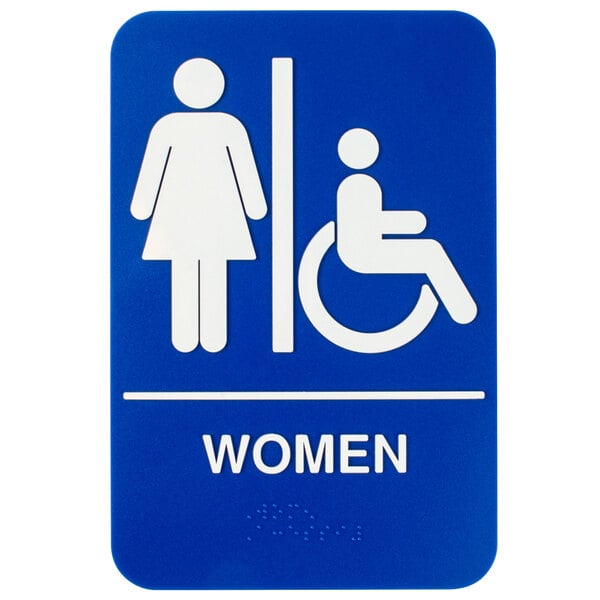
Reprinted from Webstaurant Store
The Americans with Disabilities Act, or ADA, was an important piece of civil rights legislation that was signed in 1990. The law asserts that businesses must take every possible step to allow people with disabilities to enjoy the same products and services that are available to other customers. It also deals with the Equal Employment Opportunities Commission to make sure that employees are not discriminated against because of a disability. The following guidelines will help you as a restaurant or business owner to recognize the requirements of the ADA, and to comply with them so that your establishment can be a positive and accessible place for all customers and employees.
Customer Accessibility

The biggest hurdle that business owners face when dealing with ADA compliance is the removal of barriers. Barriers can take many forms, and not all of them are obvious to a person without a disability. It may seem impossible to rearrange and reconstruct your business for compliance, but the ADA was not established to cause financial ruin. The removal of barriers is only necessary when it is readily achievable for a business to do so. If the removal of a barrier will require excessive costs that the business cannot afford, the barrier may remain until it is readily achievable to remove it. Below is a list of the types of barriers that should be removed in existing structures and avoided in new ones being built. ADA.gov lists detailed, specific requirements for fixing all of the following problems.
Removing Architectural Barriers
Architectural barriers block disabled patrons from accessing your establishment in the same way that able bodied patrons can. The removal of these barriers is an important part of ADA compliance. By altering the following areas of your business, you can make the largest impact on physical accessibility.
Parking and Building Entrance
Patrons with disabilities must not only be provided with parking spaces that are close to your business, but they must also be given adequate space to exit their vehicles, and a clear, accessible path into your business from there. The entrance must be flush with the ground, or must have a ramp with a slight slope and safety rails so that customers in wheelchairs may enter. If there is no way to make your main entrance accessible and you have other entrances that could be (for example your back door that is for employees only), you must open those up to the public and clearly note where that entrance is located. If your business operates on the third floor of a building with no elevator, for example, you can make compliance readily achievable by making your services available for delivery to customers’ homes or cars.
Doors

Even if disabled customers can approach your business easily, they may have a hard time getting in if your entrance is not ADA compliant. Entrances must be at least 36 inches wide to accommodate customers in wheelchairs, and handles cannot require squeezing or turning to accommodate customers with mobility disabilities like arthritis. Loop and lever style handles are compliant, knob and panel styles are not.
Facility Layout
Once customers enter your store or restaurant, they must be able to move around safely and efficiently. Aisles between shelves or tables must be at least 36 inches wide, and merchandise cannot be out of reach of customers in wheelchairs unless there are employees that are readily available to help. This rule also applies to self-service counters with condiments or flatware in fast food restaurants.
Restrooms

It is important to meet ADA bathroom requirements by ensuring your restrooms are accessible to disabled customers, including blind and wheelchair-bound patrons. There must be enough space for a wheelchair to maneuver around the toilet and the sink, and safety bars are necessary to prevent falls. Installing braille restroom signs is an easy way to convey useful information to blind customers. There must also be enough space under the sink so a wheelchair user can reach the soap and faucet, and the handles of the soap dispenser and faucet must be easy to use for customers with mobility disabilities. Check out this planning guide for detailed instructions to help you design an ADA compliant restroom in your restaurant.
Sales Counters and Tables
Checkout counters must have a section that is no higher than 36 inches to be accessible to customers in wheelchairs, unless they are equipped with auxiliary counters. If this is not readily achievable, a simple fix such as offering the customer a clipboard can be made.
Restaurant tables must meet certain height requirements as well, and if the tables in your establishment are fixed, at least one table must have movable chairs.
Tax Benefits for ADA Compliance
Although compliance sometimes costs money, the IRS Code states that all businesses are eligible for tax deductions when installing ADA compliant equipment or removing barriers. The maximum deduction is $15,000 per year, and small businesses are also eligible for a tax credit that can cover up to 50% (up to $10,250 per year) of compliance related expenditures. Large businesses (large businesses have over 30 employees or revenues of $1 million or more in the previous year) are only eligible for the deduction.
ADA Compliance for Employees
The ADA was written to protect both business patrons and employees. As a business owner or hiring manager, it is extremely important to understand both aspects of the ADA. Here are some steps you can take to ensure ADA compliance with your employees.
Make Reasonable Accommodations When Possible
Under the ADA, it is illegal to refrain from hiring someone solely based on their disability. If you become aware that a potential hire is disabled, you must work with him or her to find a reasonable accommodation. Reasonable accommodations allow the employer to alter the way the job is performed so the disabled employee can do the job. This could potentially mean transferring the employee to a different position if that is possible.

The employer does not have to make an accommodation if it proves to be an undue hardship, which means a significant financial expense, disruption, or change to the business. For example, if you run a grocery store and a potential cashier has a chronic back injury that prevents her from standing for long periods of time, you can accommodate her by allowing her to use a stool at the cash register, even if other cashiers are required to stand. It would be illegal to discriminate against this person if she is qualified for the job because this accommodation would not change the nature of your business or cause undue financial hardship.
You can also make reasonable accommodations by transferring an employee to a different department. If a potential cashier has a learning disability that prevents him from counting out correct change, you could consider hiring him to stock shelves instead. However, if a stocking job is not available, you do not have to give him the cashier position because he is not qualified for the job if he must handle cash.
Avoiding Discrimination During the Hiring Process
Some disabilities may be immediately visible when a potential employee comes in for an interview, but others do not present themselves right away. It is illegal to ask interviewees about any disabilities they may or may not have before presenting them with a conditional job offer. Contingent upon that offer, the employer may ask about potential disabilities to see if a reasonable accommodation must be made, but only if they ask the same questions of all employees with conditional job offers. They cannot revoke that job offer if the employee discloses that they do have a disability unless making accommodations would cause undue hardship to the business.
There are plenty of ways to accommodate both customers and employees with disabilities. It is important for the employer to be willing to work with disabled employees, both to avoid accusations of discrimination and to create an open work environment for everyone. Reading and learning about the ADA’s rules for reasonable accommodation is the best way to ensure that you’re providing a fair and equal opportunity for all employees. As it becomes possible, work to eliminate architectural barriers in your restaurant or business so that all patrons can experience what you have to offer.
